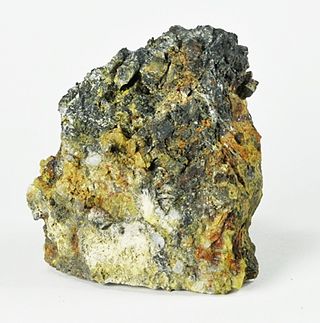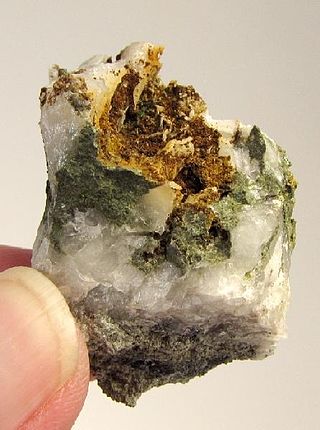
Pyrochlore2Nb2O6(OH,F) is a mineral group of the niobium end member of the pyrochlore supergroup. Pyrochlore is also a term for the crystal structure Fd3m. The name is from the Greek πῦρ, fire, and χλωρός, green because it typically turns green on ignition in classic blowpipe analysis.

Thorite, (Th,U)SiO4, is a rare nesosilicate of thorium that crystallizes in the tetragonal system and is isomorphous with zircon and hafnon. It is the most common mineral of thorium and is nearly always strongly radioactive. Thorite was discovered in 1828 on the island of Løvøya, Norway, by the vicar and mineralogist, Hans Morten Thrane Esmark. First specimens of Thorite were sent to his father, Jens Esmark, who was a professor of mineralogy and geology. It was named in 1829 to reflect its thorium content.

Triplite is a rare phosphate mineral with formula: (Mn, Fe)2PO4(F, OH). It occurs in phosphate-rich granitic pegmatites typically as irregular brown opaque masses. Triplite was first described in 1813 for an occurrence in Chanteloube, Limousin, France. The name is from the Greek triplos for triple, in reference to the three cleavage directions. In color and appearance, it is very similar to rhodocrosite, another manganese bearing mineral. Chemically, it is also quite similar to triploidite the difference being that triplite is fluorine dominant while triploidite is hydroxide dominant.

The name apophyllite refers to a specific group of phyllosilicates, a class of minerals. Originally, the group name referred to a specific mineral, but was redefined in 1978 to stand for a class of minerals of similar chemical makeup that comprise a solid solution series, and includes the members fluorapophyllite-(K), fluorapophyllite-(Na), hydroxyapophyllite-(K). The name apophyllite is derived from the Greek apophyllízo, meaning 'it flakes off', a reference to this class's tendency to flake apart when heated, due to water loss. Exfoliation of apophyllite is also possible by treating it with acids or simply by rubbing it. These minerals are typically found as secondary minerals in vesicles in basalt or other volcanic rocks. A recent change (2008) in the nomenclature system used for this group was approved by the International Mineralogical Association, removing the prefixes from the species names and using suffixes to designate the species. A subsequent nomenclature change approved by the International Mineralogical Association in 2013 renamed the minerals to include both suffixes and prefixes, as shown above.

Microlite was once known as a pale-yellow, reddish-brown, or black isometric mineral composed of sodium calcium tantalum oxide with a small amount of fluorine. Its chemical formula is(Na,Ca)2Ta2O6(O,OH,F). Today it is a name of a group of oxide minerals of a similar stoichiometry having tantalum prevailing over titanium and niobium. The microlite group belongs to a large pyrochlore supergroup that occurs in pegmatites and constitutes an ore of tantalum. It has a Mohs hardness of 5.5 and a variable specific gravity of 4.2 to 6.4. It occurs as disseminated microscopic subtranslucent to opaque octahedral crystals with a refractive index of 2.0 to 2.2. Microlite is also called djalmaite, but both names are now obsolete.

Fluor-buergerite, originally named buergerite, is a mineral species belonging to the tourmaline group. It was first described for an occurrence in rhyolitic cavities near Mexquitic, San Luis Potosi, Mexico. It was approved as a mineral in 1966 by the IMA and named in honor of Martin J. Buerger (1903–1986), professor of mineralogy at the Massachusetts Institute of Technology. It has also been reported from Minas Gerais, Brazil, and the Central Bohemia Region of the Czech Republic.

Hydrokenoelsmoreite is a hydrous tungsten oxide mineral with formula □2W2O6(H2O). Hydrokenoelsmoreite is a colorless to white, translucent isometric mineral. It has a Mohs hardness of 3, exhibits no cleavage and has a splintery fracture. It has a vitreous to adamantine luster. It is optically isotropic with an index of refraction of n = 2.24.

Loparite-(Ce) is a granular, brittle oxide mineral of the perovskite class. It is black to dark grey and may appear grey to white in reflected light on polished thin section with reddish brown internal reflections. It has the chemical formula of (Ce,Na,Ca)(Ti,Nb)O3. Nioboloparite is a variation of Loparite-(Ce) containing niobium.

Roméite is a calcium antimonate mineral with the chemical formula (Ca,Fe,Mn,Na)2(Sb,Ti)2O6(O,OH,F). It is a honey-yellow mineral crystallizing in the hexoctahedral crystal system. It has a Mohs hardness of 5.5-6.0. It occurs in Algeria, Australia, Brazil, China, Europe, Japan, New Zealand, and the United States in metamorphic iron-manganese deposits and in hydrothermal antimony-bearing veins.

Stillwellite-(Ce) is a rare-earth boro-silicate mineral with chemical formula (Ce,La,Ca)BSiO5.
Georgerobinsonite, named for George Willard Robinson, is a lead chromate mineral with formula Pb4(CrO4)2(OH)2FCl. It exhibits very small, transparent crystals with a bright orange-red color. It was obtained from the Mammoth–St. Anthony Mine in Arizona in the 1940s and identified in 2009.

Pascoite is a mineral with formula Ca3V10O28·17H2O that is red-orange to yellow in color. It was discovered in the Pasco Province of Peru, for which it is named, and described in 1914.
Magnesiopascoite is a bright orange mineral with formula Ca2Mg(V10O28)·16H2O. It was discovered in the U.S. state of Utah and formally described in 2008. The mineral's name derives from its status as the magnesium analogue of pascoite.

Oxyyttropyrochlore-(Y), also referred to as "obruchevite" or "yttropyrochlore-(Y)", is a potential (not yet accepted) zero-valent-dominant mineral of the pyrochlore group. Its formula can be written as (Y,◻)2Nb2O2O.
Billwiseite is a very rare oxide mineral found at the pegmatite commonly referred to as "Stak Nala" located within a few hundred yards from the village of Toghla in the Stak Nala, Gilgit-Baltistan, Pakistan. It has only been found as a coating on a single crystal of lepidolite. The sole rock containing Billwiseite is kept at the Royal Ontario Museum, catalogue number M5595.

Rakovanite, (NH4)3Na3(V10O28) · 12H2O; formerly given as Na3(H3V10O28).15H2O; later, the ammonium ion was shown to be present and essential, is a member of the pascoite family. It is a transparent, brittle mineral occurring in the monoclinic crystal system. It is orange in color and has an orange-yellow colored streak. Rakovanite is soft with a Mohs hardness of 1 and a calculated density of 2.407g cm−3. It does not fluoresce in long- or short-wave ultraviolet radiation. Rakovanite crystals are up to one mm in maximum dimension and vary in habit from blocky to prismatic on [001], commonly exhibiting steps and striations parallel to [001]. Its name honors John Rakovan, former professor, Department of Geology and Environmental Earth Science, Miami University, State Mineralogist and Senior Museum Curator, New Mexico Bureau of Geology and Mineral Resources.

Zirsilite-(Ce) is a very rare mineral of the eudialyte group, with formula (Na,□)12(Ce,Na)3Ca6Mn3Zr3NbSi(Si9O27)2(Si3O9)2O(OH)3(CO3)·H2O. The original formula was extended to show the presence of cyclic silicate groups and the presence of silicon at the M4 site, according to the nomenclature of the eudialyte group. Zirsilite-(Ce) differs from carbokentbrooksite in cerium-dominance over sodium only. Both minerals are intimately associated. The only other currently known representative of the eudialyte group having rare earth elements (in particular cerium, as suggested by the "-Ce)" Levinson suffix in the name) in dominance is johnsenite-(Ce).

Trogtalite is a rare selenide mineral with the formula CoSe2. It crystallizes in the cubic system and is part of the pyrite group, consisting of Co2+ and Se22− ions. It has a rose-violet colour and its crystals are opaque. It often occurs as grains. It was thought to be dimorphous with hastite, but this was discredited in 2009. Hastite turned out to be the iron selenide mineral ferroselite. It forms a solid solution series with kruťaite.

Khinite is a rare tellurate mineral with the formula Pb2+Cu2+3TeO6(OH)2 It crystallizes in the orthorhombic system and has a bottle-green colour. It is often found as dipyramidal, curved or corroded crystals no more than 0.15 mm in size. The tetragonal dimorph of khinite is called parakhinite.


















